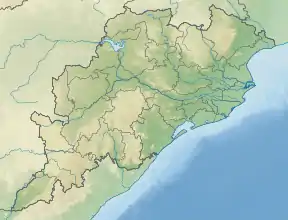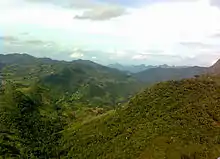Simlipal National Park
Similipal National Park is a national park and a tiger reserve in the Mayurbhanj district in the Indian state of Odisha covering 2,750 km2 (1,060 sq mi). It is part of the Mayurbhanj Elephant Reserve, which includes three protected areas — Similipal Tiger Reserve, Hadgarh Wildlife Sanctuary with 191.06 km2 (73.77 sq mi) and Kuldiha Wildlife Sanctuary with 272.75 km2 (105.31 sq mi).[1] Simlipal National Park derives its name from the abundance of red silk cotton trees growing in the area.[2] It is the 7th largest national park in India.
| Similipal National Park | |
|---|---|
| Odia: ଶିମିଳିପାଳ ଜାତୀୟ ଉଦ୍ୟାନ | |
IUCN category II (national park) | |
 | |
 Similipal National Park, Odisha | |
| Location | Odisha, India |
| Nearest city | Baripada |
| Coordinates | 21°50′N 86°20′E |
| Area | 2,750 km2 (1,060 sq mi) |
| Established | 1980 |
| Governing body | Ministry of Environment and Forests, Government of India |
| Website | www |

The park is home to Bengal tiger, Asian elephant, gaur, and chausingha.[3] along with some of the beautiful waterfalls like Joranda and Barehipani Falls.
This protected area is part of the UNESCO World Network of Biosphere Reserves since 2009.[4][5]
Description
Covering a vast area of 2750 km2 out of which 303 km2 from the core area, thick biosphere reserve is a sanctuary and one of the tiger projects and national parks of India. With a wide range of rainfall and edaphic variations, from dry deciduous to moist green forests, it is suitable to many species of flora and fauna. About 1076 species of mammals, 29 types of reptiles and 231 species of birds are in this plateau. The average mean elevation of Similipal is 900 meters. There are tall sal trees in large numbers. The peaks of Khairiburu (1178 meters), Meghasani (1158 meters) and others welcome. Sweet scented champak flowers freshen the air. The richly hued orchids on the green foliage are soothing. In the midst of the dense forests, the summer stands humbled. Several rivers like Budhabalanga, Khairi, salandi, Palpala, etc. originate from the hills and meander through the forest. Many of them have cascading rapids and foaming falls before leaving for the plains.
The panoramic views of the waterfalls at Barehipani (217 meters) and Joranda (181 meters)[6] are enchanting. Fish is found in abundance in most of the rivers. The silence of Similipal is occasionally broken by the chirping of the birds. The dense forest and riverine system serve as an excellent home to some of the most beautiful creatures.
History
Simlipal elephant reserve originated mainly as a hunting ground for the royalty. It was formally designated a tiger reserve in 1956 and under Project Tiger in May 1973. "Mugger Crocodile Scheme" was started in 1979 at Ramatirtha, Jashipur.
The Government of Odisha declared Simlipal as a wildlife sanctuary in 1979 with an area of 2,200 square kilometres (850 sq mi). Later in 1980, the state government proposed 303 square kilometres (117 sq mi) of the sanctuary as a national park. Further in 1986, area of the national park was increased to 845.70 square kilometres (326.53 sq mi). Government of India declared Simlipal as a biosphere reserve in 1994. UNESCO added this national park to its list of Biosphere Reserves in May 2009.[4][5] There are 10,000 people living in 61 villages in the forest. That is why Simlipal is yet to be declared a full-fledged park, despite its having the status of one of the 18 biospheres of India.[7]
Relocation of core villages
In December 2013, 32 families from the Khadia tribe belonging to two hamlets of Upper Barhakamuda and Bahaghar were relocated outside the Tiger Reserve as per the guidelines set by National Tiger Conservation Authority. The village of Jamunagarh was relocated in September 2015. Following the relocation, tiger sightings in the core area has gone up. There are two villages, Kabatghai and Bakua, still present in the core area of Similipal. The Forest Department, wildlife NGOs and local administration have initiated talks with these villages on their relocation. However the tribals alleged these relocations to be forced and wished to claim their rights under the Forest Rights Act.[8]
Geography and climate.
The park is in the Mayurbhanj district in the Indian state of Odisha. Simlipal Elephant Reserve is an ecosystem complete with forest vegetation (mainly sal trees), fauna and the adjoining Ho / Santhal tribal settlements. The park has an area of 2,750 square kilometres (1,060 sq mi). The average elevation is 559.31 metres (1,835.0 ft).[2] However, the Similipal area is undulating, rising from 600 metres (2,000 ft) to 1,500 metres (4,900 ft).
The high hills surround Meghasani/Tunkiburu, the highest peak in the park.[9] At an altitude of 1,165 metres (3,822 ft), followed by Khairiburu at above 1,000 metres (3,300 ft) elevation.[10] At least 12 rivers cut across the plain area. The prominent among them are Budhabalanga, Palpala Bhandan, Kharkai River and Deo.[9] This sprawling forest has two prominent waterfalls - Joranda/Jorodah 181 metres (594 ft) and Barheipani/Barhai 217 metres (712 ft) [6] that gives a panoramic view to the park.
Summers are hot with temperatures around 40 °C (104 °F) whereas the winter months can be as low as 14 °C (57 °F). The rainfall ranges from moderate to heavy.[11]
Simlipal comes under a high cerebral malaria-prone zone. In cerebral malaria the sequestrated red blood cells can breach the blood brain barrier possibly leading to coma.[12] Cerebral malaria, if not detected, causes death within 15 days of infection.
Initial symptoms of cerebral malaria are often mistaken as those of acute jaundice. There have been many recorded cases of death due to cerebral malaria after visits to Simlipal.[13] Therefore, it is extremely important for tourists to be aware of the threats posed by cerebral malaria before planning a visit to Simlipal.
Wildlife
Flora
The park is a treasure house of 1076 species of plants belonging to 102 families. 96 species of orchids have been identified here.[10] It lies in the Eastern Highlands moist deciduous forests ecoregion, with tropical moist broadleaf forest and tropical moist deciduous forests with dry deciduous hill forest and high level Sal forests.[2] The grasslands and the savannas provide grazing grounds for the herbivores and hiding place to the carnivores. The forest boasts of innumerable medicinal and aromatic plants, which provide a source of earnings for the tribal people. Eucalyptus, planted by the British during the 1900s, are found.[10]
Fauna
A total of 42 species of mammals, 242 species of birds and 30 species of reptiles have been recorded in Simlipal National Park.[10] The major mammals include tiger, leopard, Asian elephant, sambar, barking deer, gaur, jungle cat, wild boar, chausingha (four horned antelope), giant squirrel and common langur. 231 species of birds nest in these forests. Red junglefowl, hill mynah, peafowl, Alexandrine parakeet, crested serpent eagle are the commonly found birds. The grey hornbill, Indian pied hornbill, Malabar pied hornbill and Indian trogon are also found in the reserve.
The park has a sizeable population of reptiles, which includes snakes and turtles. The "Mugger Crocodile Management Programme" has helped the Mugger crocodile (Crocodylus palustris) to survive and flourish on the banks of Khairi river.[2]
Citations
- http://www.similipal.org/elephant_reserve.php
- "Simlipal National Park". Department of tourism, Odisha. Retrieved 12 December 2009.
- Jena 2005, p. 110
- "Three Indian sites added to UNESCO list of biosphere reserves". Sify News. 27 May 2009. Retrieved 30 May 2009.
- "UNESCO Designates 22 New Biosphere Reserves". Environment News Service. 2009. Retrieved 30 May 2009.
- http://www.similipal.org/destinations.php#5
- Jena 2005, p. 111
- "Relocation of tribal people living around Similipal Tiger Reserve forceful, claim locals". Mongabay-India. 30 March 2020. Retrieved 12 January 2021.
- http://www.wwfindia.org/about_wwf/critical_regions/national_parks_tiger_reserves/similipal_tiger_reserve/
- Jena 2005, p. 112
- https://mausam.imd.gov.in/imd_latest/contents/rainfallinformation.php
- Adams, S; Brown, H; Turner, G (2002). "Breaking down the blood–brain barrier: signaling a path to cerebral malaria?". Trends Parasitol. 18 (8): 360–6. doi:10.1016/S1471-4922(02)02353-X. PMID 12377286.
- "Report of the Fact Finding Team on Infant Death in Simlipal Sanctuary" (PDF).
References
- Jena, Mona Lisa (2005). "Similipal's Scenic Splendor". Women's Era. 32 (752): 110–112. External link in
|journal=(help)
External links
| Wikimedia Commons has media related to Simlipal National Park. |
 Simlipal National Park travel guide from Wikivoyage
Simlipal National Park travel guide from Wikivoyage




